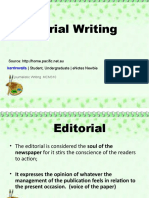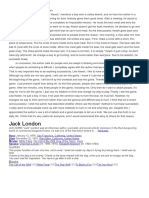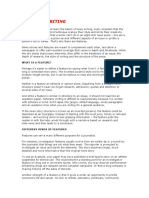How To Write A Profile Feature Article
How To Write A Profile Feature Article
Uploaded by
AndreeaCopyright:
Available Formats
How To Write A Profile Feature Article
How To Write A Profile Feature Article
Uploaded by
AndreeaOriginal Title
Copyright
Available Formats
Share this document
Did you find this document useful?
Is this content inappropriate?
Copyright:
Available Formats
How To Write A Profile Feature Article
How To Write A Profile Feature Article
Uploaded by
AndreeaCopyright:
Available Formats
How to Write a Profile Feature Article
Adapted from The New York Times on the Web As a student journalist, your mission is to inform your peers. Your fellow students look to your work to help them understand the nuances of the environments they inhabit, and to accurately represent their experiences and views. Here are a few guidelines that should help you report and write for the national audience you will have if your submission is selected for publication on The New York Times Learning Network.
1. Know the rules of attribution. You must identify yourself as a student at Coe College and tell your subject that you are writing a news article for our class Web site. You can tell your subject more about our class and give them the URL if they are interested (and they likely will be.) Its not ethical to write something about a person without letting them know -- and getting their OK -- that this will be published on the Web. 2. Ask open questions, be a good listener, and probe for anecdotes. Get a subject talking by asking questions that begin with "how" or "why." Once a subject starts talking, try to keep him or her going by asking follow-up questions like, "What do you mean by that?" or "Can you give me an example?" 3. Prepare for your interviews. As much as you can and as much as the assignment allows, come to your interview armed with a basic list of questions you hope to ask. If the conversation goes well you can (and should) toss your questions and go with the flow, but if you have a terse source your questions should be a big help in keeping the conversation going. When interviewing leaders and experts, you should always have a basic understanding of the work they have done which has prompted you to look to those people as sources. 4. Write for a national audience. Your profile will be grounded by our Bicycle Writing class and Web site, but look for recent research or studies that may help illuminate some of the points your article makes. This will give your profile wider appeal. Once you're ready to write: 1. Decide on an approach. Outlining your story is the best way to start. This means reviewing your notes, marking the most interesting or articulate quotes, making a list of important points, and creating a structure into which you can fit your information. Spend extra time of the beginning of your story. Readers will decide whether to proceed based on the capacity of your lead to grab their interest. 2. Focus on what's most compelling. Before you start writing, think through all the information you have and all the points you plan to make. What's surprising? What's important? What's useful? 3. Show, don't tell. It is tempting to describe a room as messy or a person as nice. But carefully observed details and well-chosen verbs make a much stronger impression than adjectives.
4. Put your story in context. You must help answer a reader's biggest question about any story: Why should I care? 5. Don't overuse direct quotes. Sometimes you can best capture a mood with your own prose. Think of direct quotes as icing on a cake -- they enhance, but they shouldn't form the substance of your story. The quotes you do use must be attributed, always. The reader should not have to guess who is talking. 6. Fill holes. Are there questions raised by your story that you have not answered? Ask a friend, teacher, editor or fellow reporter to read through your story and tell you what else he or she would want to know. 7. Triple-check for accuracy. Spell names right. Get titles right. Get facts right. If you are unsure of something and cannot verify it, leave it out. Before you turn in your story, ask yourself these questions: Have I attributed or documented all my facts? Are the quotes in my story presented fairly and in context? Am I prepared to publicly defend my facts if they are questioned? 8. Proofread. Do not turn in a story with spelling or grammatical mistakes. A "profile feature" is a newspaper article that explores the background and character of a particular person (or group). The focus should be on a news angle or a single aspect of the subject's personal or professional life. The article should begin with the reason the subject is newsworthy at this time, and should be based (not exclusively) on an extensive interview with the subject. Biographical material is important, but should not be overemphasized: the biography is background to the news. Readers should be allowed to better understand the subject by seeing this person in the context of his or her interests and career, educational and family background. When reporting a profile feature article, observe your surroundings carefully. Pay attention to your subject's habits and mannerisms. Subtle clues like posture, tone of voice and word choice can all, when presented to readers, contribute to a fuller and more accurate presentation of the interview subject. When interviewing, encourage your subject to open up and express significant thoughts, feelings or opinions. Do so by asking open-ended questions that are wellplanned. If you can, make sure to research the subject of your profile before beginning your interview. This will help you to maintain focus during the conversation and to ask questions that will elicit compelling responses. The article should open with the subject's newsworthiness and should deal later with birth, family, education, career and hobbies, unless one of those happens to be the focus of the story. Profile features should include the major elements of hard news stories, but should also provide readers with details help to capture the essence of the person you are profiling. Contextual information should clearly show readers why the profile subject you have chosen is relevant and interesting.
Since features are typically reported and written over a much longer period of time than event-driven news, they should be carefully researched and supported with as much background material as possible. Check the library, the Internet and experts for previous news coverage and references to key information. Profile feature leads are often more creative than news leads. They don't always need to contain the standard "five w's (and h)": who, what, when, where, why and how. (These elements should, however, be aggregated somewhere in your article in what has come to be known as a "nut graf," the paragraph that clearly explains to readers who your profile is about and why this person is interesting.) A profile feature lead can take one of many forms. A ggod one is a "delayed lead," in which a person is introduced before his or her relevance is revealed. An example: As a young girl growing up on the South Side of Chicago, Mae C. Jemison watched telecasts of the Gemini and Apollo spaceflights and knew that that was her destiny. No matter that all the astronauts were male and white and that she was female and black. She simply knew she would be a space traveler. Now a 35-year-old doctor and engineer, Dr. Jemison has realized her dream, launching into orbit yesterday as one of the shuttle Endeavor's sever-member crew. In the process she has become the first African-American woman to go into space. ... When structuring your story, don't feel tied to the "inverted pyramid" style of writing, in which the most important information is placed in the first paragraph and proceeds retrogressively from there. Consider weaving background material with details and quotes, and when choosing an order in which to present your information, move thematically rather than chronologically. Don't end your article with a conclusion. Consider saving a particularly resonant quote for the last sentence. This way your article will end with a voice the reader may be left hearing long after he or she has finished your story.
You might also like
- Janina Fisher Healing Traumatic Wounds Brief Therapy Conf 2018 Handout Read OnlyDocument17 pagesJanina Fisher Healing Traumatic Wounds Brief Therapy Conf 2018 Handout Read Onlysoulxpress100% (13)
- Sa Babeng Nangarap Maging TeacherDocument2 pagesSa Babeng Nangarap Maging TeacherCamille Ann Faigao Famisan0% (1)
- The Folded EarthDocument11 pagesThe Folded EarthGrea GuevarraNo ratings yet
- Sonnet I by Jose Garcia VillaDocument5 pagesSonnet I by Jose Garcia Villa15-0001100% (1)
- Lord of The Rings Critique Review EssayDocument2 pagesLord of The Rings Critique Review EssayNicolette Dream GreenNo ratings yet
- Exemplification EssayDocument2 pagesExemplification Essaytjb2bl100% (2)
- Review / Game / Discussion: EDUC101: Child and Adolescent Learners and Learning PrinciplesDocument41 pagesReview / Game / Discussion: EDUC101: Child and Adolescent Learners and Learning PrinciplesConses DianneNo ratings yet
- Unfamiliar Words and Their MeaningsDocument1 pageUnfamiliar Words and Their MeaningsAjay Kumar100% (1)
- 21 Century Literature From The Philippines and The WorldDocument2 pages21 Century Literature From The Philippines and The WorldJay Reyes De GuzmanNo ratings yet
- Review of Related LiteratureDocument5 pagesReview of Related Literaturechristopher layupanNo ratings yet
- Feature WritingDocument40 pagesFeature WritingRomy Jr Delos SantosNo ratings yet
- PDF (SG) - EAP 11 - 12 - UNIT 5 - LESSON 1 - Different Citation StylesDocument17 pagesPDF (SG) - EAP 11 - 12 - UNIT 5 - LESSON 1 - Different Citation StylesMayNo ratings yet
- Five Brothers One MotherDocument3 pagesFive Brothers One MotherSheena Baltar RamirezNo ratings yet
- HyperpoetryDocument3 pagesHyperpoetryVirgilio BiagtanNo ratings yet
- South East Asian Literature, Irony, and ModalsDocument3 pagesSouth East Asian Literature, Irony, and ModalsLana Kristin GalliguezNo ratings yet
- Editorial WritingDocument47 pagesEditorial Writingvillamor niez0% (1)
- POETRYDocument68 pagesPOETRYDenchel Minga100% (3)
- Plot ElementDocument11 pagesPlot ElementAlonaNo ratings yet
- REGION IIIDocument22 pagesREGION IIIBea Dacillo BautistaNo ratings yet
- My Brothers Peculiar ChickenDocument24 pagesMy Brothers Peculiar ChickenCamelaAngelicaCresencioLacsamaNo ratings yet
- Journalistic WritingDocument9 pagesJournalistic WritinghaizeNo ratings yet
- 21st AureaDocument66 pages21st AureaJudith R. CamachoNo ratings yet
- Carlos P. Romulo 1Document40 pagesCarlos P. Romulo 1Grace Rabina100% (1)
- Common Proofreading SymbolsDocument7 pagesCommon Proofreading SymbolsCharles NunezNo ratings yet
- E10-Q3 Melc 3 Las-2Document7 pagesE10-Q3 Melc 3 Las-2Leo EvidorNo ratings yet
- Oceans and Lakes Have Much in CommonDocument2 pagesOceans and Lakes Have Much in Commonraymart copiarNo ratings yet
- Allegorical Analysis in Third World Geography: Laguna Senior High SchoolDocument4 pagesAllegorical Analysis in Third World Geography: Laguna Senior High SchoolAldrin PabloNo ratings yet
- 21st Literature Week 2Document5 pages21st Literature Week 2denzxxNo ratings yet
- Deriving Research Ideas and QuestionsDocument10 pagesDeriving Research Ideas and QuestionsRonyl PinlacNo ratings yet
- 21st-Century-Lit-PTW-m5Document20 pages21st-Century-Lit-PTW-m5Mikaela Sai ReynesNo ratings yet
- Misogynistic Subjugation by Feminism in Yvette Tan's "Seek Ye Whore"Document7 pagesMisogynistic Subjugation by Feminism in Yvette Tan's "Seek Ye Whore"Akira Mitz Gonzales Marasigan0% (2)
- Twilight Book ReviewDocument2 pagesTwilight Book Reviewapi-485780930No ratings yet
- Mommy J at San Vicente WardDocument1 pageMommy J at San Vicente Wardmarvin fajardoNo ratings yet
- Group 1 KULOT RevisedDocument15 pagesGroup 1 KULOT RevisedFranchesca Mekila TuradoNo ratings yet
- 21st Century Lit Module 5&6Document18 pages21st Century Lit Module 5&6Marichelle Idmilao PurosNo ratings yet
- Literary Criticism - 21st CDocument2 pagesLiterary Criticism - 21st CGabrielle mari BulawanNo ratings yet
- Do You Believed in Love at First Sight?: Unknown StoryDocument13 pagesDo You Believed in Love at First Sight?: Unknown StoryFrancis Bryan Hantal PatinoNo ratings yet
- Speculativ E Fiction: Group 2Document28 pagesSpeculativ E Fiction: Group 2qwertasdfgNo ratings yet
- Point of ViewDocument22 pagesPoint of ViewNeeru SharmaNo ratings yet
- Lj-Eng 2Document57 pagesLj-Eng 2Charrie Faye Magbitang HernandezNo ratings yet
- The Fence by Jose Garcia VilllaDocument3 pagesThe Fence by Jose Garcia VilllaHannah Denise BatallangNo ratings yet
- Reading 21 Century Literature From The Philippines and The World: Critical ApproachesDocument24 pagesReading 21 Century Literature From The Philippines and The World: Critical ApproachesR2CA100% (1)
- Mayon Volcano PoemDocument2 pagesMayon Volcano PoemCathy SabladaNo ratings yet
- Learning: Graphic, Linguistic, and Ethnic Dimensions of Philippine Literary HistoryDocument17 pagesLearning: Graphic, Linguistic, and Ethnic Dimensions of Philippine Literary HistoryZarah Joyce Segovia50% (2)
- The Story of KeeshDocument3 pagesThe Story of KeeshNeil Constantino MartinezNo ratings yet
- CRHW 16Document2 pagesCRHW 16Bhekis VlogsNo ratings yet
- Structuralism Approach: By: Lady Lyn S. Paguio Maed - EnglishDocument38 pagesStructuralism Approach: By: Lady Lyn S. Paguio Maed - Englishkristen caalim0% (1)
- Condemned ExcerptDocument2 pagesCondemned Excerptjessica clementeNo ratings yet
- National Artists in Philippine LiteratureDocument17 pagesNational Artists in Philippine LiteratureJayson Paul Dalisay DatinguinooNo ratings yet
- 21st Century Literary GenreDocument27 pages21st Century Literary GenreRaiza LloricoNo ratings yet
- The History of Philippine LiteratureDocument3 pagesThe History of Philippine LiteratureAbi Refugio Cabuñag50% (2)
- Jose Garcia VillaDocument5 pagesJose Garcia Villamaricon elleNo ratings yet
- MODULE 2 Classic and Contemporary FictionDocument8 pagesMODULE 2 Classic and Contemporary Fictiontroyguimary9No ratings yet
- Fables and Parables FinalDocument29 pagesFables and Parables FinalIrene TagalogNo ratings yet
- 21ST CenturyDocument67 pages21ST Centurykrislyn marie layosNo ratings yet
- English 10 MODULE2C - Q3Document14 pagesEnglish 10 MODULE2C - Q3Lyle Isaac L. IllagaNo ratings yet
- Text: Questions:: Instructions: Read The Given Texts. Answer The Questions For Each Text AfterwardsDocument3 pagesText: Questions:: Instructions: Read The Given Texts. Answer The Questions For Each Text AfterwardsCassy BulataoNo ratings yet
- Prep For JournalismDocument135 pagesPrep For JournalismMaxn ClairNo ratings yet
- How To Write A Profile Feature ArticleDocument4 pagesHow To Write A Profile Feature ArticleMidsy De la CruzNo ratings yet
- 2-How To Write A News ArticleDocument5 pages2-How To Write A News Article5p7htgy6chNo ratings yet
- Eature Riting: What Is A Feature?Document5 pagesEature Riting: What Is A Feature?Melanie Nina ClareteNo ratings yet
- Legal Letters OutlineDocument29 pagesLegal Letters Outlinetconn8276No ratings yet
- Curriculum Implementation PhilosophyDocument6 pagesCurriculum Implementation Philosophyapi-601832805No ratings yet
- Theories of PsycholinguisticsDocument7 pagesTheories of PsycholinguisticsHammad ShawNo ratings yet
- Six Point Lesson Plan STAR Academy: Text Reference ObjectivesDocument1 pageSix Point Lesson Plan STAR Academy: Text Reference ObjectivesrdgloriaNo ratings yet
- Directing Lesson PlanDocument1 pageDirecting Lesson PlanKate MellitzNo ratings yet
- Depression - Types, Causes and TreatmentDocument2 pagesDepression - Types, Causes and TreatmentMindFit LabNo ratings yet
- Answer Scheme Paper 2 2016Document6 pagesAnswer Scheme Paper 2 2016Suhaila Nik Ismail Azlan43% (7)
- Albi Film Studies Analysis Theme Trough Cinematic LanguageDocument3 pagesAlbi Film Studies Analysis Theme Trough Cinematic LanguageUchiha Dava SyahriandriNo ratings yet
- Grade 3 DLL ENGLISH 3 Q2 Week 3Document3 pagesGrade 3 DLL ENGLISH 3 Q2 Week 3Jessa Versoza CalisteNo ratings yet
- "K" Top 6, 2019 Bar ExamDocument4 pages"K" Top 6, 2019 Bar Examjojo50166No ratings yet
- Feldman & Conee Internalism - DefendedDocument36 pagesFeldman & Conee Internalism - DefendedneosofistaNo ratings yet
- Vocabulary For Better WritingDocument7 pagesVocabulary For Better Writingsandesh patoliyaNo ratings yet
- Management Practices AssignmentDocument10 pagesManagement Practices AssignmentIera BalqisNo ratings yet
- Longman Student Grammar of Spoken & Written English Longman Student Grammar of Spoken & Written EnglishDocument4 pagesLongman Student Grammar of Spoken & Written English Longman Student Grammar of Spoken & Written EnglishAnonymous oQixEiNo ratings yet
- BTC School BookletDocument12 pagesBTC School BookletKunjan AmbreNo ratings yet
- DLP - Intro (Performance Task)Document1 pageDLP - Intro (Performance Task)Jennifer MagangoNo ratings yet
- Official Test Guide Versant 4 Skills EssentialDocument21 pagesOfficial Test Guide Versant 4 Skills EssentiallucoxxxxNo ratings yet
- Music Psychology EssayDocument5 pagesMusic Psychology Essayharshinithiyagarajan2008No ratings yet
- Chapter 6: Perception and Individual Decision Making: 6-1. Explain The Factors That Influence PerceptionDocument3 pagesChapter 6: Perception and Individual Decision Making: 6-1. Explain The Factors That Influence PerceptionPhạm Châu Thuý KiềuNo ratings yet
- Student-Centered Mentoring Keeping Students at The Heart of New Teachers' Learning (Amanda Brueggeman) (Z-Library)Document233 pagesStudent-Centered Mentoring Keeping Students at The Heart of New Teachers' Learning (Amanda Brueggeman) (Z-Library)João Paulo Da Mata100% (2)
- Daily Lesson Log in Organization and ManagementDocument12 pagesDaily Lesson Log in Organization and ManagementRitchelle MabandosNo ratings yet
- Hum 1 Lesson 1Document47 pagesHum 1 Lesson 1CJ Ericka CapulongNo ratings yet
- Trauma and Psychoanalysis: Freud, Bion, and Mitchell: C. Fred AlfordDocument11 pagesTrauma and Psychoanalysis: Freud, Bion, and Mitchell: C. Fred AlfordRTU Himig RizaliaNo ratings yet
- Theories Early Childhood Finlanda PDFDocument14 pagesTheories Early Childhood Finlanda PDFwolfdare11No ratings yet
- FCVM 09 945726Document22 pagesFCVM 09 945726Vimal NishadNo ratings yet
- Responsible Digital Behavior - Digital EtiquetteDocument17 pagesResponsible Digital Behavior - Digital EtiquetteEmmaNo ratings yet
- ZoologyDocument2 pagesZoologyPsyche RouchlessNo ratings yet
- Rubrics For Formal ReportDocument1 pageRubrics For Formal ReportGrawpNo ratings yet

























































































